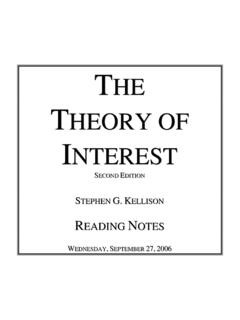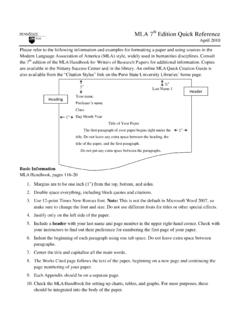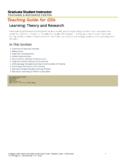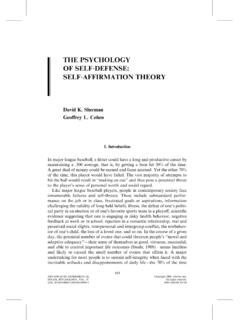Transcription of The Systems Theory of Communications - WordPress
1 Running head: THE Systems Theory OF Communications IN 1. PRACTICE IN PUBLIC RELATIONS. The Systems Theory of Communication in Practice in Public Relations Sarah Gassmann Penn State University THE Systems Theory OF COMMUNICATION IN PRACTICE IN PUBLIC 2. RELATIONS. Abstract The Systems Theory of Communications has been in practice since the early 1950's. Proposed by biologist Ludwig Von Bertalanffy and further developed by psychologist Ross Ashby, Systems Theory states that analyzing an entity as part of a larger whole or system is beneficial in determining the proper course of action for said entity.
2 A large part of understanding Systems Theory is the self correcting feedback loop that an entity goes through when adhering to the principles of Systems Theory . That is, an entity can evaluate the results of its actions in regard to all the parts of the system that it is within, and can correct its future actions based on those results. Systems Theory in Communications can easily be applied to any organization, and the actions of the organization can be applied to the output of the public relations team. Systems , self-correcting, entity, public relations THE Systems Theory OF COMMUNICATION IN PRACTICE IN PUBLIC 3.
3 RELATIONS. The Systems Theory of communication is one of the most critical for a public relations practitioner to understand if they want to meet the goals of their organization. In general, Systems Theory states that all things can be evaluated as part of a larger whole. This applies to Communications and public relations in the sense that a public relations professional must evaluate their organization as just one piece of a puzzle that is interdependent on their many stakeholders and their constituents in the community for success. Systems Theory has a history in many other disciplines, but it is worthwhile to examine the history of Systems Theory as it applies to Communications , and which crucial pieces of the Theory helps public relations be successful within an organization.
4 Systems Theory was proposed first by Ludwing Von Bertalanffy, and later developed further by Ross Ashby in the 1950's. Bertalanffy was a biologist hailing from Austria, and his development of Systems Theory encompassed much more than just Communications . Bertalanffy suggested that studying entities as Systems that are related to one another and affect one another could help better understand the function of a specific system (Drack, 2008). Bertalanffy originally applied this Theory to biology, engineering, and psychology. For example, in psychology, Bertalanffy suggested that studying human behavior is most beneficial and can achieve the best results when studying humans interactions with one another as part of a system, rather than considering a person as an individual with no bearing on their surroundings (Drack, 2008).
5 Ashby, the second contributor to Systems Theory was an English psychiatrist. From 1962-1964, Ashby was the president of the Society for General Systems Research. This society, which was established in 1956, legitimized Systems Theory as a true area of study especially in the social sciences. THE Systems Theory OF COMMUNICATION IN PRACTICE IN PUBLIC 4. RELATIONS. One of the most important concepts from Systems Theory is the emphasis on self- correcting Systems . That is, when an entity receives feedback , it will correct the next cycle of activity it performs in regard to that feedback .
6 This concept can be easily related to public relations when keeping in mind the rest of the Theory , that an organization must be evaluated as one part of an interdependent whole. For example, if a public relations team launches a campaign meant to further the goals of its organization, it must consider how its stakeholders, the intended audience, and the media will perceive the campaign. In the figure below, it can be clearly seen how all of these aforementioned entities are connected (Ball-Rokeach & DeFleur, 1976). This figure also demonstrates how important it is to consider the self-correcting feedback loop portion of the Theory .
7 Public relations professionals can take the feedback they receive, be it positive or negative, to re-engineer their next campaign in a way that is more pleasing and affective in the eyes of the stakeholders. This Theory has been used in a number of different instances in public relations. One particular area of public relations where this self-correcting feedback loop becomes THE Systems Theory OF COMMUNICATION IN PRACTICE IN PUBLIC 5. RELATIONS. extremely important is in recovery from a crisis (Rhee, 2004). One specific crisis that is an exemplary model for correcting and improving the actions of an organization to better fit the needs of the system it resides in is the Tylenol arsenic poisoning crisis of 1982.
8 Seven Chicago residents were reported dead after purchasing and taking extra strength Tylenol, and it was later discovered that the bottles of Tylenol they had bought had been tampered with to add cyanide, a deadly chemical (Stewart & Paine, 2011). This incident had the power to completely destroy the reputation of Johnson and Johnson, Tylenol's parent company, and had to be handled with great care. The only way to achieve success in this situation was to think about the role of the company within a larger societal setting, and listen to the concerns being voiced by the stakeholders and the publics.
9 The crisis management team responded nearly perfectly using the principles of Systems Theory . The three most important steps that Johnson and Johnson took while examining how to respond to the crisis were identifying the ethical issues and points of conflict, identifying the most relevant affected parties, and identifying the relevant community standards that should guide a decision made by a person of integrity (Stewart & Paine, 2011). Considering these points before creating a response shows that the public relations team was fully aware that they were in a fragile interdependent network.
10 Johnson and Johnson called for an immediate recall of Tylenol that cost over $100 million, even though it was well known that the company itself was not responsible for the poisoning (Stewart & Paine, 2011). Though the recall was extremely costly, the overall benefits outweighed the initial monetary cost. Johnson and Johnson solidified their image as a company who cares about the safety of its consumers first and foremost. By using the self correcting feedback loop and considering what the publics thought was THE Systems Theory OF COMMUNICATION IN PRACTICE IN PUBLIC 6.














